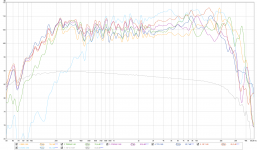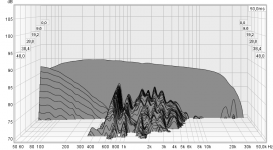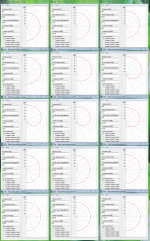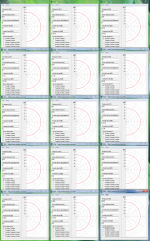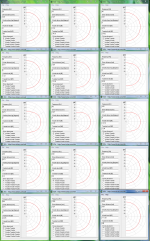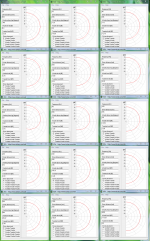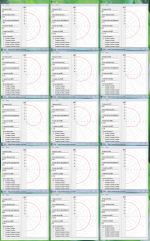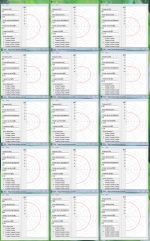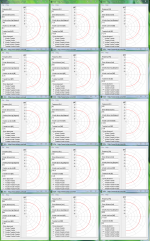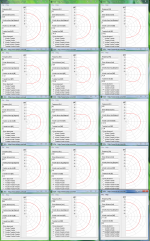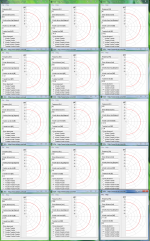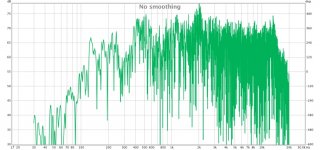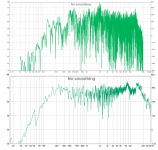That FF85WK looks pretty nice. They all look pretty smooth, would love to see plot with less smoothing applied. I had peaky-sibilance.
Hi Bigun,
Gating was frq dependant window (FDW) 1/6 width in octaves and probably a very good first wave-front gating spec to base EQ correction so that all categorys of gating including raw thereafter will show improvements.
Same overlay below 1/12 smoothing without gating, out of box response without any correction 10F is hard to beat but also cost is thereafter, they all comparable sitting on same baffle and noting changed except device under test.
If you ask me and is open to more modern DSP and get a DSP that can run up at 96kHz or 192kHz we can get these nice full rangers to perform excellent tweeter performance, added my own FAST exercise speaker (grey curve) to below overlay curves and what you see is 10F having duty from 96dB/oct at 180Hz and a controlled known roll off slope at very high frq, it is measured at 96kHz rate where the others are measured at 192kHz rate, 1st order roll off at 100Hz lows are because speaker is on wall and that spec numbers happen to suit this particular room. High rate DSP'ed you can get rid of any nasty peaky-sibilance and many real tweeters will be very jealous : )
Can show you my waterfall 20dB down from 20Hz and up for this exercise speaker where next step is to get rid of foam core ratling enclosure that 10F sits in which is responsible what we see in middle of waterfall and was amplified when i shifted XO point from 355Hz down to 180Hz to be within 1/8 wavelength at XO point. Measurement point in space for waterfall is on axis at 62cm correction point for XO and system slopes and can report sound experience is very delicate and gets you into recording room. Pretty shure with this low 180Hz XO point included DSP correction TC9 (better ventilation) will beat 10F in this exercise setup because its best of them all in HD at low frq its just the snob in me and because i have it that make me use 10F, SB65/TEBM46/FF85WK have less cone and ventilation area that will show if used too low in frq at same reachable SPL as TC9/10F.
Attachments
Last edited:
Member
Joined 2009
Paid Member
Hey thanks a lot !
Again, all these drivers look pretty good. This size of driver does seem to be a kind of sweet spot. But I would like make stuff without DSP for now, mostly because I'm still playing with the older ways of doing things, a right of passage perhaps. I'm planning on building my own active XO since I've never done one before. So I'd prefer drivers with as few warts as possible to start with. I like the FR of the FF85 apart from the 10k peak (TC9 is similar in that regard) but I'd have to hear them before I'd know if it was an issue. The 10F does look smoother, but needs tilting down a little.
I won't build anything just yet but am soaking up information from you guys. I am thinking I'll make a pair of boxes for the full-range (mid-treble) and a pair of boxes for the woofer and then I can orient, offset and otherwise play around with them to see what I like. In my room. With my ears. As they say.
Again, all these drivers look pretty good. This size of driver does seem to be a kind of sweet spot. But I would like make stuff without DSP for now, mostly because I'm still playing with the older ways of doing things, a right of passage perhaps. I'm planning on building my own active XO since I've never done one before. So I'd prefer drivers with as few warts as possible to start with. I like the FR of the FF85 apart from the 10k peak (TC9 is similar in that regard) but I'd have to hear them before I'd know if it was an issue. The 10F does look smoother, but needs tilting down a little.
I won't build anything just yet but am soaking up information from you guys. I am thinking I'll make a pair of boxes for the full-range (mid-treble) and a pair of boxes for the woofer and then I can orient, offset and otherwise play around with them to see what I like. In my room. With my ears. As they say.
Last edited:
Hi X, Hi BYRTT,
Do you think th epassive design with the 10F could be improved by a little upper XO (let say 700 to 800 Hz) to winn a little in max spl outputt... and of course without wasting the FAST concept ?
Are you happy with the 10F in the treble without horn and DSP correction ?
regards
Do you think th epassive design with the 10F could be improved by a little upper XO (let say 700 to 800 Hz) to winn a little in max spl outputt... and of course without wasting the FAST concept ?
Are you happy with the 10F in the treble without horn and DSP correction ?
regards
Hi Bigun,
Welcome glad we can help each other some good information data values, if you go active analog XO way could imagine tame your responses it will be great help use spreadsheets from Charlie's audio pages (software) or also this link (Software) looks like can pass acoustical parameters of driver and enclosure into electrical spice.
Welcome glad we can help each other some good information data values, if you go active analog XO way could imagine tame your responses it will be great help use spreadsheets from Charlie's audio pages (software) or also this link (Software) looks like can pass acoustical parameters of driver and enclosure into electrical spice.
Hi Eldam,
Pretty happy myself DSP corrected 10F performance using traditional baffle but also directly compared its pretty complicated system setup and radical other room dispersion than principle of simple 1st order passive than X use to get him a speaker useable to test sound stage for new builds of diy power amps.
Pretty happy myself DSP corrected 10F performance using traditional baffle but also directly compared its pretty complicated system setup and radical other room dispersion than principle of simple 1st order passive than X use to get him a speaker useable to test sound stage for new builds of diy power amps.
Last edited:
You won't believe it, I have always my 10F I purchased after the X's tests !
Lol !
I can't decide myself to dive into MiniDSP because I saw the D/A chain is also very important, at least to me !
I don't give up the idea to use it with a horn as well, but more Something with 1.4" throat in FR as a FAST as well ! maybe 2" with a tweeter above 8/10 K : mainly to minimize the influence of the passive filter in the main sensibility zone of the ears... But a simple monitor could be find also, have too much old speakers already ! Curious to hear what can do those little moderns drivers at home, also against compression drivers !
thank you for all the inputs here.
Eldam
Lol !
I can't decide myself to dive into MiniDSP because I saw the D/A chain is also very important, at least to me !
I don't give up the idea to use it with a horn as well, but more Something with 1.4" throat in FR as a FAST as well ! maybe 2" with a tweeter above 8/10 K : mainly to minimize the influence of the passive filter in the main sensibility zone of the ears... But a simple monitor could be find also, have too much old speakers already ! Curious to hear what can do those little moderns drivers at home, also against compression drivers !
thank you for all the inputs here.
Eldam
Last edited:
Hi X, Hi BYRTT,
Do you think th epassive design with the 10F could be improved by a little upper XO (let say 700 to 800 Hz) to winn a little in max spl outputt... and of course without wasting the FAST concept ?
Are you happy with the 10F in the treble without horn and DSP correction ?
regards
I think crossover at 700Hz is fine. I myself use a 600Hz crossover frequency and find the FAST concept to be still very engaging with the RS225-8 covering the low end. When you free the 10F from doing any bass duties, it has very very low distortion. If you put it in a FLH (like a tractrix) for 600Hz and above, it will have even less distortion (circa -60dB) as cone movement is only about 40 um for 95dB SPL. So plays unbelievably loud yet so clean, you cannot tell how loud it is due to lack of distortion clues we normally use to tell ourselves it is loud. Wearing hearing protection is a must when doing sine sweeps of the 10F in a horn and standing nearby. I would accidentally hit 115dB sometimes and my ears would ring afterwards from doing measurements.
Member
Joined 2009
Paid Member
Sounds good tool Bigun myself haven't any experience using all pass trick but lot of builds had been successful tuned that way, other than first active diy speaker was pure analog then went DSP way where delay is neat build in feature, Harsh XO should be good on improve transients normally ruined by minimum phase XO region, if it ends take too many analog stages of all pass filters and because its mid-tweeter that needs the set back then maybe look into some small physical help step baffle a little, and if eyes and tools allow round overs it should pay back going 2-3 inch radius roundovers, not because its not correctable with minimum phase filters but because it change a little with distance and a lot with angle plus its uneven at left or right side of speaker if drivers not mounted in horizontal center of baffle so cure it the most possible at root should pay back.
Harsch seems end a tilted acosutic lobe for XO region as with uneven order XOs so to tweak it for in room situation and taste WT can be flipped 180º as xrk971 do for his 1st order passive setup. Share below how it will look plotted in free XDir, XO point there is 80Hz and ctc spacing within 1/4 wavelenght and to read and understand it maximize picture so to see the various frq points above and below XO point, configuration there is WT and tilt will change to strait forward lobe as for even order XOs if going WTW configuration but also beam will get a little more narrow then.
Harsch seems end a tilted acosutic lobe for XO region as with uneven order XOs so to tweak it for in room situation and taste WT can be flipped 180º as xrk971 do for his 1st order passive setup. Share below how it will look plotted in free XDir, XO point there is 80Hz and ctc spacing within 1/4 wavelenght and to read and understand it maximize picture so to see the various frq points above and below XO point, configuration there is WT and tilt will change to strait forward lobe as for even order XOs if going WTW configuration but also beam will get a little more narrow then.
Attachments
Last edited:
Member
Joined 2009
Paid Member
A tilted lobe at 80Hz hardly seems worth worrying about as the wavelength will be very long. But I think this is too low to cross over the full range mid-tweet. 80Hz is more for subwoofer XO than the FAST. I think the FF85WK for example would need an XO in the range of 300Hz. Wouldn't you agree ?
Agree and to explain why sharing it at 80Hz is because that was number used for example, it takes a lot of work plus time to create visual overview and for every XDir window you see one have to read out curves and fill in all the exacts numbers by hand, but its still usefull for other frequencies in they relative look the same above and below XO point so for a 300Hz example it should be possible calculate new frq numbers relative to the one used there.
Distance for ctc spacing makes a lot of difference to dispersion in XO region and improve on acoustics gets closer to a real one point source as i guess we full ranger lovers seek for : ) the one shared was for within 1/4 wavelength and below show same Harsch at 1/4 wavelength then Harsh at 1/8 wavelength and last two is even order LR4 at same respective 1/4 plus 1/8 wavelength. For exercise had for some time running 10F within 1/8 wavelength of woofer, improvement for coherent tonality at whatever listening position is fantastic and include probably not only more coherent direct sound but also better coherent reflections.
Distance for ctc spacing makes a lot of difference to dispersion in XO region and improve on acoustics gets closer to a real one point source as i guess we full ranger lovers seek for : ) the one shared was for within 1/4 wavelength and below show same Harsch at 1/4 wavelength then Harsh at 1/8 wavelength and last two is even order LR4 at same respective 1/4 plus 1/8 wavelength. For exercise had for some time running 10F within 1/8 wavelength of woofer, improvement for coherent tonality at whatever listening position is fantastic and include probably not only more coherent direct sound but also better coherent reflections.
Attachments
Member
Joined 2009
Paid Member
Very interesting Byrtt 1 I have been thinking of not just the full range + woofer that we see in this thread. I have also been looking closely at the Tysen thread. This is also a FAST speaker design. Instead of a single woofer on the front baffle, it uses two woofers, in phase, with one place on each side panel. This seems a very interesting approach to me too.
Sound good plan Bigun and think i remember had read that nice Tysen thread in the past. Post 852 visuals was WT config and we now in WTW config so attach these below and as can be seen all the design power you can put into get ctc within or close to 1/8 wavelength will pay back and get dispersion in XO region very close to a real one point source. Into planning my own experience for what woofer high pass corner to target at is that Jeff Bagby spreadsheet "Baffle Edge Diffrator Simulator v1.2" works very good to find inverse room gain for particular situation and then design your acoustic hardware and active filter to suit that numbers.
This time attachments is for WTW configuration, first two are HARSCH within 1/4 plus 1/8 wavelength, and last two is even order LR4 within 1/4 plus 1/8 wavelength.
This time attachments is for WTW configuration, first two are HARSCH within 1/4 plus 1/8 wavelength, and last two is even order LR4 within 1/4 plus 1/8 wavelength.
Attachments
Made some tests with the W8-1363sbf and TC9 I have.
The W8 behaves as it should, but as I have said earlier, I can't get the TC9 to go past 15kHz before dropping. I tried with 2 different sound cards, and in 2 different rooms, I still get the drop. Mic was at listening position, from 1.5 to 2m. Drivers aimed at the mic directly. Aiming away is worse, obviously.
My ears don't work above 15kHz, so for myself, it's not a great care, but for some younger ears around me, it would probably make a difference.
The W8 behaves as it should, but as I have said earlier, I can't get the TC9 to go past 15kHz before dropping. I tried with 2 different sound cards, and in 2 different rooms, I still get the drop. Mic was at listening position, from 1.5 to 2m. Drivers aimed at the mic directly. Aiming away is worse, obviously.
My ears don't work above 15kHz, so for myself, it's not a great care, but for some younger ears around me, it would probably make a difference.
Attachments
Sorry the things don't behave normal or properly perceval, for most easy trouble shooting you could hang on a tweeter into exactly same chain as TC9 sits, if that also show limited bandwidth it must be microphone or chain that limit bandwidth, if for example your microphone have USB interface your OS could accidently have set its sample rate lower than its specification, for example UMIK-1 is a 48kHz interface and UMM-6 is a 44,1kHz interface. If coil in TC9 had by accident been overloaded and boiled it could probably start show lower HF reach but guess you have tried measured both of them so probably unlikely they both should be hurt.
Hello Byrtt,
Yes, I forgot to mention I also swapped amplifiers to make sure the Home Theatre amp was not acting up.
I also measured the W8-1772 at the same time as the TC9. basically just turned amp off, unhook the TC9 and hook the W8 instead, turned on the amp and measured, changing nothing else.
The W8-1772 sweep reached 20kHz.
I have now 2 more TC9s, so I will swap the ones that are mounted now for the other 2 and measure again.
Maybe the TC9s like the cold air in Europe, but not the warm and humid air of the tropics!
Yes, I forgot to mention I also swapped amplifiers to make sure the Home Theatre amp was not acting up.
I also measured the W8-1772 at the same time as the TC9. basically just turned amp off, unhook the TC9 and hook the W8 instead, turned on the amp and measured, changing nothing else.
The W8-1772 sweep reached 20kHz.
I have now 2 more TC9s, so I will swap the ones that are mounted now for the other 2 and measure again.
Maybe the TC9s like the cold air in Europe, but not the warm and humid air of the tropics!
Ha ha if they too wet take them to the beach a sunny day, it really sounds weird having much lower HF reach than W8-1772 and actual Denmark also have relative high humid air but summer time period is much too short, look forward where this story ends, keep us updated when clues show up down the line.
To help a bit find below my measurement on cardboard baffle in a 192kHz chain verse yours, tried to set everything the closets to the same including curve color, a big difference is beside we know Taiwan has much better weather it also has a lot more acoustic green grass
To help a bit find below my measurement on cardboard baffle in a 192kHz chain verse yours, tried to set everything the closets to the same including curve color, a big difference is beside we know Taiwan has much better weather it also has a lot more acoustic green grass
Attachments
- Home
- Loudspeakers
- Full Range
- 10F/8424 & RS225-8 FAST / WAW Ref Monitor
